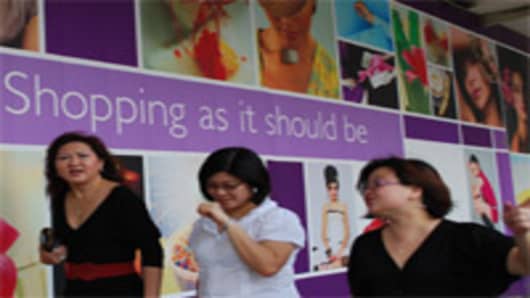As consumers in the U.S. and Europe continue to tighten their purse strings, retailers from the West are increasingly looking to tap Asia's growing demand for overseas brands, particularly in the region's retail hub - Singapore.
"Singapore is a first and an important step into Southeast Asia...(it) is a strategic and exciting market with great fashion awareness and spending power. We see a vast potential for expansion," Lex Keijser, Country Manager of Hennes & Mauritz (H&M) Singapore, told CNBC.com.
The Swedish fashion giant, which is gearing up to launch its flagship store in Singapore’s main shopping district on September 3, is not the only well-known retailer setting up shop in the island city this year. Ohio-based, teen apparel retailer Abercrombie & Fitch plans to debut in the city in December, just in time to cash in on the holiday shopping season.
In addition to the local shopping culture that makes Singapore an attractive destination for retailers, the city-state is also a magnet for regional tourists looking for a quick shopping fix, primarily from Malaysia, Indonesia, China, Australia, and India.
According to latest statistics from the Singapore Tourism Board, shopping accounts for 36 percent of a visitor’s total spend.
“One of the major attractions of coming to Singapore is shopping,” said a 40-year-old housewife visiting from India. “For a family of three, over a week, we easily spend an average of S$3,000-4,000 ($2,500-$3,300).”
During the two-month annual Great Singapore Sale that ended this year on July 24, retailers saw a ramp up in credit card spend. Visiting MasterCard cardholders spent more than $450 million from late May to July, a spike of more than 40 per cent over last year.
Transactions by Singapore-based MasterCard cardholders increased 50 percent to $865 million.
Singapore: A Giant Shopping Mall
Singapore, often nicknamed “a large shopping mall” by expatriates living in the city, has no plans to change that image.
In fact, by 2013, Orchard road, the city’s high street for shopping, will welcome two new malls, in addition to the current 20-or-so shopping complexes.
While the influx of foreign brands into the city is positive for consumers, the country’s retail landscape is becoming increasingly competitive.
“It has certainly become very exciting and challenging to some extent in Singapore, for consumers it is wonderful… for operators some are doing well, some are not doing so well,” said Nash Benjamin, CEO of Singapore-based FJ Benjamin, which distributes and retails brands such as Guess, Banana Republic and Gap in Southeast Asia.
FJ Benjamin reported a 55 percent rise in full-year net profit to S$12.8 million for the year ended June.
And undeterred by competition Benjamin plans to bring new brands into the market.
“We are planning to expand… we plan to grow by adding on some new brands which we may announce in the near-term, so whilst the situation globally doesn’t look too promising… we are cautiously optimistic that there is still growth and business carries on,” Nash said.


